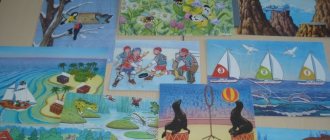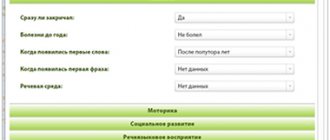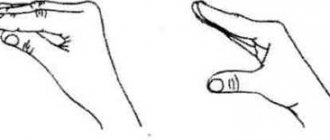Using pictograms in working with children with general speech underdevelopment of preschool age
Bogdanova Alexandra
Using pictograms in working with children with general speech underdevelopment of preschool age
Using pictograms in working with children with general speech underdevelopment of preschool age.
Compiled by: Bogdanova A. S., Lushch N. I., Subbotina A. B.
State Institution CSSV "School of Circus Arts named after Yu. V. Nikulin"
Vocabulary mastery is an important aspect of child development. Violations in mastering the lexical system of a language significantly complicate the child’s communication and cooperation with adults and peers, negatively affects the formation of his cognitive activity, delays the development of both oral and written speech , and serves as an obstacle to mastering the school curriculum. A special place for the active assimilation of all structures of the native language in the formation and development of the lexicon belongs to preschool age . Issues of speech , including vocabulary, of preschool children are discussed in the works of M. M. Alekseeva, A. N. Gvozdeva, V. V. Gerbova, F. A. Sokhina, E. M. Strunina, E. I. Tikheeva, V. I. Yashina and others.
Researchers note that children with general speech underdevelopment (GSD)
of preschool age are characterized by significant deviations from their normally developing peers, both in quantitative and qualitative characteristics of vocabulary. Children with OHP have a poverty of active and passive vocabulary, imprecise, undifferentiated use of words, expansion of generic concepts, insufficient differentiation of general concepts, errors in correlating words with specific and general meanings.
In this regard, the topic we have chosen, “ Use of pictograms in working with preschool-age children ” is relevant.
The relevance of using pictograms in working with preschoolers is that :
1. Pictograms make it easier for children with GSD ( general speech underdevelopment )
mastery of coherent speech.
2. Pictograms use natural memory mechanisms, increase memory capacity, and develop children’s speech and thinking activity.
3. Using the pictogram method increases interest in classes.
A pictogram is a pictorial letter, a set of graphic images that a person comes up with himself for the purpose of memorizing and subsequently reproducing any words and expressions.
Pictograms are visual , demonstration material and each word and phrase has its own image, reflecting the main distinguishing feature. This method allows children to memorize new words much faster and use them in constructing phrases and sentences. Preschoolers get the opportunity not only to hear their own and spoken speech, but also “ see ”
her. In our activities we implement the following tasks:
1. Formation of the phonetic side of speech .
2. Development of coherent speech
3. Development of higher mental functions, namely correction of attention, memory, visual perception.
4. Development of creativity and imagination.
5. Increasing motivation in speech therapy classes.
6. Adaptation to the surrounding reality.
With preschool children who have general speech underdevelopment , work is carried out in stages :
1. Familiarize the child with the sign and symbol and clarify his understanding.
2. Establishing a connection between the image of objects and their functions (we suggest connecting the pictogram-object with the pictogram-action : pyramid - play, spoon - eat, pencil - draw).
3. Independent construction of a phrase by choosing symbols.
method can be used in any educational activity:
1. Formation of a healthy lifestyle (physical exercises)
.
2. Retelling of works.
3. Memorizing poems and riddles.
4. Didactic games.
Pictograms for poems , stories, fairy tales, and riddles are good for developing coherent speech .
We use pictograms in our ; children really like it and make it easier for them to memorize new material.
Let's demonstrate how to memorize a poem using pictograms with examples of children's work :
Theme "Spring"
The sun looks out the window
Spring has come to visit us
We'll clap our hands
We were really looking forward to the warmth.
Thus, the pictogram creates an image , which is important for using the visual memory mechanism. Therefore, pictograms not only speed up recording, but also contribute to the memorization of material, force to work and perceive not words, but images. The use of pictograms to form a dictionary is a modern, relevant, accessible way of teaching preschoolers with SEN , which makes it possible to use pictograms as a means of facilitating the development of speech , cognitive functions, and reducing the time of studying material. Mastering the techniques of working with pictograms expands the possibilities of the correctional educational process. The child develops all analyzers: visual, motor, auditory. The child also develops the skill of writing a descriptive story and accumulates both passive and active vocabulary. Visual-figurative thinking, symbols, and diagrams develop, which underlie the formation of artificial associations, facilitate the memorization process and increase memory capacity. Using visualization in the pictogram allows you to use the most effective analyzer for perceiving information. In children with OHP, the visual system receives up to 90% of all sensory information coming from outside.
Used Books
1. Bolshova T.V. Learning from a fairy tale. Development of thinking in preschoolers using mnemonics. St. Petersburg ,2005.
2. Zhukova N. S., Mastyukova E. M., Filicheva T. B. Overcoming general speech underdevelopment in preschool children . //M., Education, 1990.
3. Omelchenko L. V. The use of mnemonic techniques in the development of coherent speech . Speech therapist. 2008.№4.
4. Linguistic encyclopedic dictionary (1990)
.
5. Ushakova O. S., Strunina E. M. Methods of speech development for preschool children . // M., Vlados, 2003
How many PECS cards should I start with?
A child, of course, will not immediately have a whole album of PECS cards. You should start with one motivational or two yes/no cards. If the child understands everything and is quick to learn, another card is added - and gradually their volume is increased to the required size.
You can make PECS cards on the topics: “a trip to grandma’s, “watching cartoons,” “brushing your teeth,” “daily schedules,” “need cards,” etc.
All activity cards must be available so that the child can use them at any time.
What children need to know about emotions
By the senior preschool age, the child has already formed an idea of human emotions, which include:
- joy
- sadness
- fear
- anger
- resentment
- astonishment
Children define and name psychological states, briefly describe them, and give examples of everyday situations in which a person experiences them.
Pictures for children depicting emotions teach the child to reason, describe cause-and-effect relationships, and analyze his own life experience.
During speech therapy work, it is useful to offer preschool children topics related to people’s experiences to compose narrative stories. For example:
- Is it only humans who have feelings?
- What are positive and negative emotions?
- When am I happy and when am I sad?
Emotions can be divided into pairs with opposite meanings. For example: joy - sadness, disgust - admiration, boredom - interest, etc. Children should be able to recognize and name the feeling of the character in the picture, but also select antonyms for the definition. Exercises in this format allow you to more firmly consolidate the characteristics of emotions.
Children should know that we can learn about a person’s psychological state both from words and by observing actions and behavior. Each emotion has a corresponding dictionary and a set:
- gestures
- facial expressions,
- actions
It is useful to have conversations with older preschoolers about how their emotional state needs to be managed, especially when it comes to negative feelings. You cannot give free rein to anger, irritation, or sadness. Express feelings only in socially acceptable ways. Children will be interested to know that in countries around the world people express feelings in different ways.
Description of the “Pictogram” test according to the method of A.R. Luria
Alexander Romanovich Luria is a follower of Lev Semenovich Vygotsky, one of the founders of Russian neuropsychology. The “Pictogram” test, developed by him as part of the development of this area of science, allows us to identify the features of memorization through associative connections. The objectives of the study are:
- identifying the nuances of indirect memorization;
- assessment of memory productivity;
- determining the nature of mental activity;
- studying the level of development of imaginative thinking.
The technique is not used for diagnosing preschoolers and primary schoolchildren, but is only suitable for testing among subjects with at least 6–7 grades of education.
Testing can only be carried out on children over 12 years of age.
How to make PECS cards yourself
PECS cards are very easy to make yourself. It is best to use photographs, because... The image is more realistic and is better perceived by the child.
You can also print pictures found on the Internet on a color printer. It is easy to make pictures of the required size by saving them in a pre-created table in Microsoft Word.
After printing, it is better to laminate or seal the cards with tape. On the back side, glue Velcro with adhesive backing, which are sold in a sewing store.
Article on the topic: Game sets for children with autism
Drawn pictures
Emotions in pictures for children, used for classes on speech development, are presented in several versions: images of adults and children, people or fairy-tale characters. Printed pictures and drawings created by children are suitable for the development of speech in preschoolers.
Invite the children to draw themselves or another person experiencing a certain feeling. Drawing up a verbal explanation for such a picture is a speech therapy exercise that the children do willingly.
If children are not yet able to cope with independent depictions of emotional states, it is worth inviting them to create a collage from pre-prepared and printed facial details. Preschoolers aged 6-7 years are able to recreate emotions on paper on their own, but for younger children it is worth using ready-made templates and samples.
In speech therapy work, you can use not only drawing, but also coloring. Thematic coloring books are a useful and exciting material that is indispensable for girls and boys in kindergarten and at home.
It is important to first thoroughly study with children not only the names of different emotions, but also those artistic techniques that allow you to accurately convey one or another psychological state of a person. The use of pictograms can be very helpful in this regard.
Application of the methodology for testing schoolchildren
The stimulus material for the test is a set of 15–20 words or phrases of concrete (“hungry child”) or abstract content (“doubt”):
- fun party;
- hard work;
- development;
- delicious dinner;
- a brave deed;
- disease;
- happiness;
- parting;
- poisonous question;
- friendship;
- dark night;
- sadness;
- justice;
- doubt;
- warm wind;
- deception;
- wealth;
- hungry child.
Moreover, the technique does not involve the use of a standardized list of words; the experimenter can create his own set or replace only a few proposed options. Thus, the test can be carried out as many times as required by working with a particular subject.
The test organizer can come up with his own set of simple phrases for diagnosis
Diagnostics are organized both in group form and individually. To conduct the study, the subject will need to be given a piece of paper and a pen or pencil.
Instructions for schoolchildren aged 12–16 years:
- The experimenter announces the conditions of the study: “We will examine your visual memory. I will begin to name the words, and your task is to draw a picture, which will then help you remember what you heard. You cannot write down or depict individual letters.”
- Then the adult clearly and loudly names the words, first specifying the serial number of each expression. The interval between utterances should not be more than 1 minute.
- While drawing, you can ask your child leading questions (“What are you drawing?” or “How will this help you remember the word?”).
- 40–60 minutes after the end of the test, during which the experimenter allows the students to do other things, the subjects are provided with forms with their answers.
- After this, the adult invites the children to independently reproduce all the words they heard, looking at the pictures shown (in the group form of the test, students will need to sign their pictograms, and in the individual test, it is recommended that the child name the concepts out of order).
For older subjects, words should be read at intervals of only 30 seconds.
During the work, the experimenter must draw the students’ attention to the fact that the test results do not depend on the level of their visual abilities.
Processing and interpretation of results
If the subject draws little people as illustrations of all concepts, then this indicates his sociability
The content of the drawings reflects the subject’s stock of knowledge, as well as some features of his life experience and ability to abstract. Pictograms are classified into 5 types:
- A - abstract (the drawn lines are not formed into a separate image);
- Z - iconic or symbolic (images are arrows, squares, trapezoids, and so on);
- K - specific (very specific objects are presented);
- C - plot (drawn pictures are united by a specific situation);
- M - metaphorical (the drawings are the artistic creation of the subject; for example, for the concept of “joy” a jumping person is depicted).
The experimenter notes the type of each pattern and then counts the frequency of use of each type:
- If abstract and symbolic images predominate (more than 55%), then the person can be classified as a group of “thinkers” who are aimed at synthesizing the information received and generalizing. Such people have a high degree of development of abstract logical thinking.
- With frequent plot and metaphorical drawings, one can conclude that the student is creatively thinking. Such subjects are called “artists.” This result is typical mainly for children 12–14 years old.
- When images are mostly represented by certain objects of the surrounding world, this indicates the predominance of a concrete and effective way of thinking. Such people strive to approach all issues from a rational point of view. They are called "practitioners". But usually such results are observed only in adults (most often in teachers and executives).
You can make a conclusion about the level of development of the conceptual apparatus by how freely the test subject reproduces words from images in the final test.
Another additional parameter that can be determined is sociability. If the subject draws little people and remembers the words without hesitation, then he probably likes to be surrounded by people. But when it is difficult for a child to navigate by drawings of people, this indicates the immaturity of the person being tested.
The author of the technique, in addition to diagnosing the quality of memorization, also proposed assessing the exhaustion of attention. To do this, it is necessary to analyze the firmness of the pressure, as well as the increasing negligence in performing the task. The more pronounced the changes in these characteristics, the higher the exhaustion.
Assessment of qualitative indicators of thinking is carried out according to 4 criteria:
- Adequacy. To understand this property, just look at 1-2 pictures. Sometimes you need to pay attention to the author’s commentary. If a logical and substantiated connection between the concept and the image is noticeable, then the experimenter marks the pictogram with a “+” sign; if there is none, “-”. More than 70% positive marks are considered normal.
- The ability to restore images after a certain amount of time. The number of correctly named words in the final test is assessed. The norm is more than 80% of words and phrases.
- Correspondence of the pictogram to the real object. Concrete drawings are scored 1 point, abstract drawings - 3 points. If the image is difficult to classify, then 2 points are counted. Then the average is determined. The norm is more than 2 points.
- Originality. If the plot of the drawings of several test subjects matches, the image is scored 1 point, which indicates a mediocrity of the approach to completing the task. If the pictogram is unique, then 3 points are given for it. An intermediate option deserves 2 points. The norm, as in the previous case, is a result of 2 points.
The Luria pictogram allows you to evaluate not only the quality and speed of memorizing information, but also to get an idea of the ability to build associative connections between a concept and its image and such an important indicator of attention as exhaustion. Thus, in a short period of time, the experimenter receives a complete picture of the development of the basic properties of the test person’s thinking.




